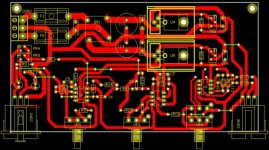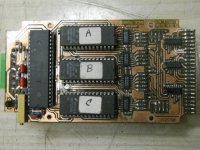Look at this. The scheme comes from an application note from National Semiconductors for his LM833. This replaced from NE5532 with a slight modification in the subtractor (or balanced to single ended converter). The rest of circuit is simillar with those in proffesional audio mixing desks. This is quite visible from the power supply of +/-18Vdc instead the usual +/-15Vdc in conventional desks. Now this compo, it works fine with any type of condencer microphone if the phantom supply of 18V is satisfactory for it. In my case the Behringer ECM8000 works with 15Volts at least so it is fine. The sound quality it is pretty good and with slight modifications in the first stage gain, can used and as line input due to the input switch who cut the power in she. I have a set of oscilograms (as usuall with square pulses) and if you can to understand these you can estimate the quality of unit. Inform me if you want to i post these oscilograms.impsick said:Foitos, your mic pre looks cool. Have you built this yet? How does it sound? Nice. I'd like to try builing this.
Fotios
In my schematic drawing, for simplicity the two presets PR4 and PR5 can be omitted and replaced by two resistors of 680Ù each. To add the posibilitty of cutting the power in the input XLR con1, so as we can making tests or connect a line level component or a dynamic mic, a toggle switch DPDT (Double Pole Double Touch) must be placed between pins 2 and 3 of con1 and the supply from PR4 and PR5 (or the two resistors of 680Ù insteed these).fotios said:Here the schematic in pdf
Another item in this preamp is that; Great carreful needed during the adjustment of input sensitivity by VR5 to avoid clipping of signal because the extremely gain level of 101 in the first stage. In proffesional mixing desks offered a Clipping Led indicator in this stage. To add a such indicator in this preamp the only needed is a comparator between the signal level and the supply rails. In the next thread these additions.
Fotios
I use the EDWIN cad/cae (if i understand correct because your reference in "eagle" files) and if it so, we can interchange the whole project in GERBER.ASCII format. All cad/cae programs, can interchange between them projects under this general format. If you have the EAGLE cad/cae and are familiar with it, inform me to post the project in GERBER.impsick said:led clip light sounds interesting. can you show an example schema? would you be willing to share your eagle files?(if that is what you used)
Fotios
O.K. In about 3 hours because i have to prepare these.impsick said:yes i have eagle. post the gerber files if you can, that would be great! thanks.
Impsick, i tried all the afternoon to open Gerber.ASCI created by Edwin with Eagle (i have downloaded Eagle today for this reason) but it is impossimble to doing this. With another program, PROTEL, this can be done. Eagle is a litle mysterious about this. At last, converted the plans in pdf format, and i checked that the size is exactly the same with the original from Edwin. So i post to you the plans in this format, and if you have the intend to make the PCB byself then you can print the pdf of layout directly to a transparency. I don't know your posibilitty to make a PCB at home but with litle effort and inexpensive tools you can make this. To encourage you for this, i enclose a photo from a double sided PCB from those i have make many times.impsick said:cool good looking out
Fotios
Attachments
In this pdf quoted the drawing of micpre.impsick said:cool good looking out
Attachments
And in this pdf the component sideimpsick said:cool good looking out
Attachments
And finally in this the solder side mirrored. Print it first in a plain paper and check for the distances with a DIL8 IC as NE5532.impsick said:cool good looking out
I wish you success.
Fotios
Attachments
EDWin CAD/CAE
I use from 1999 the CAD/CAE software of Visionics “EDWin 1.60” a complete suite which includes Schematic, Layout, Post processing, Mix mode simulator, EDSpice simulator and Library editors. It is an early version of 16 bits. However the schematic and layout symbols are my own creations as they don’t have so much beautiful appearance in the default libraries of EDWin. Also it should to say you that i think an upgrade in the new version “EDWinXP 1.50” however i hesitate because when i tried it i realised that the scrolling operation cannot become with the mouse wheel. It becomes only by the scroll bars something that does not please me because habit but it is also disadvantage in the speed of designing. It should you know that, in WindowsXP no one CAD application supports the mouse wheel for scrolling the display. This became until WindowsMe. Thus i am compelled to have dual boot system in my P.C. WindowsXP and WindowsMe. Also no one of these CAD applications supports LINUX. What i have to point out is that; with the CPU Intel P4/HT 3,2GHz that has my P.C. in WindowsMe so EDWin 1.60 as AutoCAD 2000 run much faster than in WindowsXP. The same is also happens with many other applications. I have the impression that the current CPU of Intel or AMD they are always enough steps far more from the current operating systems of Microsoft. With the upgrades of Microsoft for WinMe (unfortunately she paused to support WinMe) these became exceptionally stable and can henceforth exceed Win98 2nd edition in total performance.
Regards
Fotios
Hi frickecellofrickecello said:Nice preamp Fotios, which program do you use to draw those cool schematics?
I use from 1999 the CAD/CAE software of Visionics “EDWin 1.60” a complete suite which includes Schematic, Layout, Post processing, Mix mode simulator, EDSpice simulator and Library editors. It is an early version of 16 bits. However the schematic and layout symbols are my own creations as they don’t have so much beautiful appearance in the default libraries of EDWin. Also it should to say you that i think an upgrade in the new version “EDWinXP 1.50” however i hesitate because when i tried it i realised that the scrolling operation cannot become with the mouse wheel. It becomes only by the scroll bars something that does not please me because habit but it is also disadvantage in the speed of designing. It should you know that, in WindowsXP no one CAD application supports the mouse wheel for scrolling the display. This became until WindowsMe. Thus i am compelled to have dual boot system in my P.C. WindowsXP and WindowsMe. Also no one of these CAD applications supports LINUX. What i have to point out is that; with the CPU Intel P4/HT 3,2GHz that has my P.C. in WindowsMe so EDWin 1.60 as AutoCAD 2000 run much faster than in WindowsXP. The same is also happens with many other applications. I have the impression that the current CPU of Intel or AMD they are always enough steps far more from the current operating systems of Microsoft. With the upgrades of Microsoft for WinMe (unfortunately she paused to support WinMe) these became exceptionally stable and can henceforth exceed Win98 2nd edition in total performance.
Regards
Fotios
PLEASE HELP!
Hi guys, Im building Fotios' mic preamp, Im using a protoboard to test one channel first. Im building just the instrumentation amplifier block.
Signal amplification works, but I hear a really loud hum and buzz, I have tested it with 9v batteries, with regulated supplies with non regulated supplies and the hum remains the same. Also FM radio signals are heard in the background.
I have noticed a strange behavior:
Im connecting the output to a pair of amplified computer loudspeakers and the hum is relative to the microphone's position respect to the loudspeakers... There are some positions where the hum cancels and there are some where the hum is louder. Also if I touch the XLR jack the hum is also diminished. Ive noticed that if I remove the signal ground from pin 1, the sound remains almost the same...
I have tested the microphone in other preamp and it works, what do you guys think is happening?
Hi guys, Im building Fotios' mic preamp, Im using a protoboard to test one channel first. Im building just the instrumentation amplifier block.
Signal amplification works, but I hear a really loud hum and buzz, I have tested it with 9v batteries, with regulated supplies with non regulated supplies and the hum remains the same. Also FM radio signals are heard in the background.
I have noticed a strange behavior:
Im connecting the output to a pair of amplified computer loudspeakers and the hum is relative to the microphone's position respect to the loudspeakers... There are some positions where the hum cancels and there are some where the hum is louder. Also if I touch the XLR jack the hum is also diminished. Ive noticed that if I remove the signal ground from pin 1, the sound remains almost the same...
I have tested the microphone in other preamp and it works, what do you guys think is happening?
- Status
- This old topic is closed. If you want to reopen this topic, contact a moderator using the "Report Post" button.
- Home
- Amplifiers
- Solid State
- Fotios's microphone amplifier


